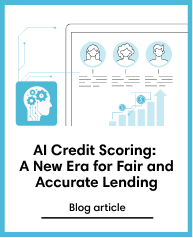Credit Scoring
Apr 2, 2021
Everything you need to know about embedded finance
Subscribe to our newsletter
In an industry where new technologies are always announcing themselves as ‘the next big thing’, there are few and far between that actually live up to their promise.
Embedded finance, however, is one development that actually does have the potential to live up to the hype. For one, it doesn’t take a large amount of effort to spot real-life examples of embedded finance: ride-sharing companies such as Grab and Uber offering financial products to both customers and drivers, large consumer tech companies like Amazon and Facebook offering digital wallets and P2P payment services, international telcos like T-Mobile carrying digital banking products, and so much more.
In this article, we’ll be going over the basics of embedded finance, including what exactly it is, who benefits from it, and why it is changing the financial services world for good.
What is it, and who benefits?
Embedded finance is best described as merging a non-financial service provider (like Grab or Facebook) and a financial service such as payment processing, lending, or insurance.
The main benefit of embedded finance is that it streamlines financial processes, turning complex exchanges into something that can be done on a smartphone with just a few button clicks. Before embedded finance, there was usually a gap between a consumer and a business they would transact with, necessitating the entry of a third party like a lender or bank to provide a loan or a credit/debit card. With embedded finance, these third parties disappear.
Embedded finance is a powerful force in reshaping the distribution model of financial services while giving a new role for tech companies in the lives of consumers and businesses. Though it certainly poses a threat to the operations of traditional financial players like banks, it opens up a world of convenience and new possibilities to the ordinary consumer.
Opportunities
Though embedded finance is mostly good news for consumers, there are also upsides for businesses. Companies with additional financial services can form a more compelling user value proposition and thus more revenue opportunities.
For example, the e-commerce platform Shopify processed $14bn (USD) gross payments volume through its Shopify Payments service in the 3rd quarter of 2020 alone. This service is offered in partnership with the bank Stripe. With Shopify Payments service, the company was able to earn an incredible amount from charging from online transactions (around $0.30 plus up to 2.9% of the customer’s total amount).
Embedded finance can even allow companies to reach out to new markets, such as the unbanked. For example, our company, credolab, works with other companies to provide solutions leveraging alternative data sources (such as flagging whether a person’s smartphone has been linked to fraud). With these alternative data sources, we can determine more accurate credit scores so that it’s no longer an issue if a person has no past financial history to judge them by.
There is already a real-world use case for how CredoLab has helped streamline financial services. In a partnership with digital-only bank CIMB Bank Philippines, CredoLab’s (discontinued) white-label mobile application CredoApp allowed Filipinos to apply for a credit loan of up to P1,000,000 even without fulfilling traditional banking requirements. With technology that analyses nearly 500,000 features from opt-in and permission smartphone metadata to assign credit scores, a process that would normally take days is now reduced to a matter of seconds.
Conclusion
Embedded finance is here to stay. The convenience and accessibility it offers are too much to ignore, and a world where transactions are increasingly digital means they may even be the most practical option around. But, unfortunately, one-stop-shop apps where users can do everything from shopping to paying for utilities aren’t innovative anymore, and they’re swiftly becoming the norm.
The logical thing to do here would be working with embedded finance rather than going against the flow. Although it’s possible to be confusing at first, the results (as shown by the real-world examples above) will certainly be worth it.





